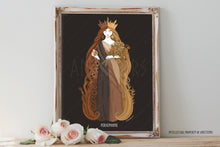

Persephone and Kore are two names associated with the same figure in Greek mythology, representing different aspects of her life and character. Persephone, whose name means "she who brings destruction," is the queen of the Underworld and the wife of Hades. Kore, meaning "maiden" or "girl," refers to Persephone's earlier life as the daughter of the harvest goddess Demeter.
The myth of Persephone and Kore centers around the abduction of Kore by Hades, which led to her becoming the queen of the Underworld. According to the myth, Kore was gathering flowers in a meadow when Hades, emerged from the depths of the Earth and abducted her to the Underworld. This event caused great distress to Demeter, who was devastated by the loss of her daughter.
During her time in the Underworld, Kore assumed the role of Persephone, the queen of the dead, after consuming some pomegranate seed. Her departure from the world above caused the earth to become barren, and her return marked the onset of spring and the blossoming of plants.
The correlation between Persephone and Kore lies in their shared identity and the duality of their roles. The abduction story can be interpreted in many ways, from being a story for mothers who lost their daughters after marriage, to the metaphorical cycle from maiden to woman. Kore represents the innocence and youth of the maiden, while Persephone embodies the power and wisdom gained through her experience as the queen of the Underworld. The myth of Persephone and Kore serves as a metaphor for the changing seasons and the cycle of life and death. It also symbolizes the eternal struggle between darkness and light, as well as the transformative power of experiences and the journey from innocence to maturity.




